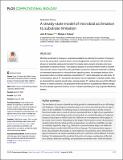| dc.contributor.author | Casey, John R. | |
| dc.contributor.author | Follows, Michael J | |
| dc.date.accessioned | 2021-12-06T14:53:43Z | |
| dc.date.available | 2021-10-27T19:53:57Z | |
| dc.date.available | 2021-12-06T14:53:43Z | |
| dc.date.issued | 2020 | |
| dc.identifier.uri | https://hdl.handle.net/1721.1/133637.2 | |
| dc.description.abstract | Microbes acclimate to changes in substrate availability by altering the number of transporters on the cell surface, however there is some disagreement on just how. We revisit the physics of substrate uptake and consider the steady-state scenario whereby cells have acclimated to maximize fitness. Flux balance analysis of a stoichiometric model of Escherichia coli was used in conjunction with quantitative proteomics data and molecular modeling of membrane transporters to reconcile these opposing views. An emergent feature of the proposed model is a critical substrate concentration S*, which delineates two rate limits. At concentrations above S*, transporter abundance can be regulated to maintain uptake rates as demanded by maximal growth rates, whereas below S*, uptake rates are strictly diffusion limited. In certain scenarios, the proposed model can take on a qualitatively different shape from the familiar hyperbolic kinetics curves, instead resembling the long-forgotten Blackman kinetics. | en_US |
| dc.description.sponsorship | Simons Foundation (Grants 549931 and 549894) | en_US |
| dc.language.iso | en | |
| dc.publisher | Public Library of Science (PLoS) | en_US |
| dc.relation.isversionof | 10.1371/JOURNAL.PCBI.1008140 | en_US |
| dc.rights | Creative Commons Attribution 4.0 International license | en_US |
| dc.rights.uri | https://creativecommons.org/licenses/by/4.0/ | en_US |
| dc.source | PLoS | en_US |
| dc.title | A steady-state model of microbial acclimation to substrate limitation | en_US |
| dc.type | Article | en_US |
| dc.contributor.department | Massachusetts Institute of Technology. Department of Earth, Atmospheric, and Planetary Sciences | en_US |
| dc.relation.journal | PLoS Computational Biology | en_US |
| dc.eprint.version | Final published version | en_US |
| dc.type.uri | http://purl.org/eprint/type/JournalArticle | en_US |
| eprint.status | http://purl.org/eprint/status/PeerReviewed | en_US |
| dc.date.updated | 2021-09-16T15:25:51Z | |
| dspace.orderedauthors | Casey, JR; Follows, MJ | en_US |
| dspace.date.submission | 2021-09-16T15:25:52Z | |
| mit.journal.volume | 16 | en_US |
| mit.journal.issue | 8 | en_US |
| mit.license | PUBLISHER_CC | |
| mit.metadata.status | Publication Information Needed | en_US |
